Elliott's Oyster House is currently celebrating their 18th annual Ocean Harvest Festival, which culminates in the Oyster New Year Bash on November 6th. It looks to be completely over the top (oyster luge and most beautiful oyster contest, anyone?) in a delicious way, with thirty varieties of local oysters shucked to order, fifty wines and microbrews, and tons of other seafood to sample. Tickets are $95 per person, or $125 if you want to go VIP and hit the oysters (and champagne) early.
But first, tonight is the Slurp Up, a mini version of the New Year's party. There's still tons of briny, supple oysters on the half shell, as well as other seafood appetizers, wine, and beer. Those tickets will only run you $35 for all the shellfish you can eat.
After Ivar's sent some samples of tartar sauce and cocktail sauce, my partner and I decided to speed over to the seafood section to prepare food for sauce tasting.
First up was fish, sans chips. Fresh, wild-caught cod deep-fried with a panko coating would be the perfect way to test the tartar sauce. My partner dove in as I readied a lemon squeeze, and she quickly screamed out a warning: "No lemon, no lemon."
Turns out this was a new Zesty Lemon Tartar Sauce, already packed with enough citrus punch. More disconcerting, though, is that it was missing enough of the cucumbers, capers, or other relish-like elements that I crave in adding texture to tartar sauce. Plus, it lacked bite that horseradish would provide. This tasted more like a lemony mayonnaise.
King crab would be a simple way to sample the cocktail sauce, which I soon realized was the new Spicy Ginger Lime Cocktail Sauce. The ginger was prominent and interesting, though not necessary for me. Lime makes sense, and luckily was less prominent than the lemon was in the tartar sauce. As for spicy, that simply wasn't happening....
The utilitarian Haas avocado is frequently on sale in these parts, and while I often simply cut slices into a salad or mash one to make guacamole, Mark Bittman's recipe for "Fast Avocado Soup" recently caught my eye.
This is simple soup. Take a few avocados, combine with an almost an equal number of cups of milk, then blend with some salt and cayenne. Chill (yourself, and the soup) for a few hours, then add some citrus to taste. (I didn't care for orange juice, but lemon or lime is fine.) Per the recipe's suggestion, I can see adding chopped cherry tomatoes and/or thinly sliced green onions, but I went the full upgrade by tossing in some cooked crabmeat with a lemon squeeze.
Good payback for your quick investment. I love the color and the creamy texture. But the soup reminded me of two cold concoctions that I like even better: avocado ice cream (from David Lebowitz's The Perfect Scoop) and avocado bubble tea with chocolate. Still, soup is more of a meal, isn't it?
Just as ma po dou fu is a favorite emergency dinner option in my home (even if there’s no ground pork in the fridge, there tends to be tofu in there, and there’s always frozen pork in the freezer), udon is ubiquitous for lunch when we’re otherwise uninspired. We do a number of noodle dishes that go beyond udon, including dan dan noodles, somen (only in summer), Phad Thai, and yakisoba, but “something udon” is generally quick and easy.
I usually prefer frozen Sanuki udon for its texture (a thicker, stiffer variety from Kanagawa prefecture), so we stock up whenever there’s a sale at Uwajimaya—with noodle packages taking over the freezer.
I like the versatility of having udon either cold or warm—in soup or not. Most often, we have kitsune udon, with the noodles served in hot dashi along aburaage (a deep-fried tofu pouch) and kamaboko fish cake. When I make a batch of kimchi (which we’ll keep forever in the fridge, letting it get more and more pungent), then it’s definitely kimchi udon time for fermented fun....
The American Cheese Society is having its annual convention at the end of August, right here in Seattle; Michael Pollan will be keynoting. They're mixing things up a little by inviting the public to their awards ceremony and Festival of Cheese, held at Benaroya Hall on Saturday, August 28, 5:30 to 9 p.m.
To publicize the cheesemonger Main Event, Beecher's owner Kurt Dammeier invited an assortment of foodies, bloggers, and media to the Pike Place store for a preview, and regaled us with stories and cheeses: "I'm Kurt Dammeier, and I'm the founder and owner of Beecher's Handmade Cheese. Middle name, Beecher, hence the name of the store."
Dammeier has been involved with the Cheese Society for five years, and is the board treasurer. "We now have over a thousand members," he said proudly. "Nearly every American cheesemaker of note will be attending this event." About 320 difference cheesemakers have entered their products into the competition.
As co-chair, Dammeier shares most of the responsibility for how this Benaroya Hall festival goes. Normally the awards ceremony is an industry event, on a separate night. But Dammeier thinks it'll be a bit of a thrill to see which cheeses win, and then have the chance to go meet the cheesemakers and taste the award-winners:...
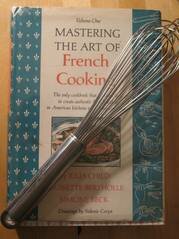 The SunBreak's own Rachael Coyle--also the Pastry Chef at Restaurant Le Pichet--is making a houseparty out of cooking school. She's beginning a series of pastry classes (held at a friendly house on Phinney Ridge) on Saturday mornings, focusing on baking fundamentals. Classes are limited to six students, and include a light lunch.
The SunBreak's own Rachael Coyle--also the Pastry Chef at Restaurant Le Pichet--is making a houseparty out of cooking school. She's beginning a series of pastry classes (held at a friendly house on Phinney Ridge) on Saturday mornings, focusing on baking fundamentals. Classes are limited to six students, and include a light lunch.
Rachael was previously a pastry instructor for Sur la Table for five years, and designed pastry classes that are used in their culinary programs nationwide. (Her degree in Pastry Arts is from the French Culinary Institute in New York, but she's not snooty at all.)
Says Rachael:
In the first class, we'll be making pie crust, and because it is April, we will be making Rhubarb Pie. We'll cover: technique for making delicious flaky, all-butter crust, tips for rolling dough evenly (and into a shape that resembles a circle rather than a continent), and pie-assembly, as well as discussing all sorts of other, later-summer-type fillings. Each student will be making his/her own dough and with it, a rhubarb pie to take home. If this class fills up, please don't fret, I will add another one.
I don't particularly care for rhubarb pie, so if you go, see if you can interest her in a nice chocolate mousse, for the next lesson.
The class is Saturday, April 24, 10 a.m.-1 p.m., on Phinney Ridge as I've mentioned, and again, a light lunch is provided. Tuition is just $35 (cash or check only), which beats the hell out of the UW, who never include a light lunch. Bring an apron and a pie plate! To RSVP, email (or ask for information about other upcoming classes).
A brief timeout from the important business of war and teh Twitter and high school sports for this bulletin: This Grace Harbor Farms Golden Guernsey yogurt, which they just started selling at Ballard Market and I'm going to assume the other Town & Country markets, is freaking delicious.
Because it's non-homogenized, the cream rises to the top of the yogurt. "You can scoop the cream off and use it like butter, or stir it in," says the package. YES PLEASE!...
 When Seattle Magazine decided to throw a street food extravaganza, it sounded like a great idea: tons of mobile food carts, collected together in one place, providing mini-bites. What could possibly go wrong?
When Seattle Magazine decided to throw a street food extravaganza, it sounded like a great idea: tons of mobile food carts, collected together in one place, providing mini-bites. What could possibly go wrong?
But the first Mobile Chowdown, held last October, turned out to be a clusterfuck of epic proportions: poorly organized, misused space, crazy-long lines, and carts running out of food. It was a post-apocalyptic hellscape *thisclose* to being The Road. Everyone I know who went took one look at the mess and left. Those who stayed suffered. (Seattle, the only city in the world where folks will patiently wait in line for hours, and then complain.)
Tomorrow (11 a.m.-3 p.m.) marks the second attempt, and word is that this time around, organizers have taken steps to ensure it runs a little more smoothly. The site's the same--the parking lot at 1616 W. Vertona--but now the carts will be spaced farther apart to keep the space organized. There will also be more staff on hand to help direct people, more clearly designated vendor line areas, and plenty o' port-a-potties. Because yes, even that was a problem last time around. ...
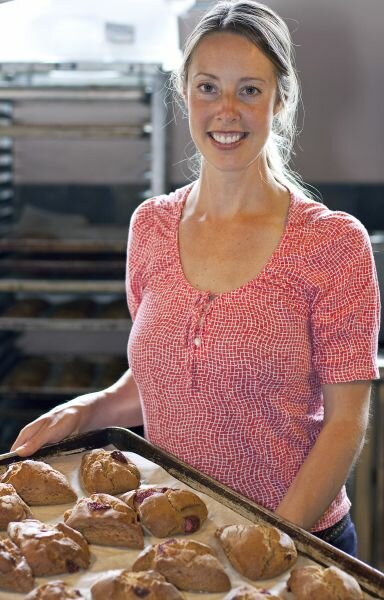 Jennifer Katzinger (Photo: Rachelle Longé)
Jennifer Katzinger (Photo: Rachelle Longé)
"I had been exposed to gluten-free at a juice bar in Greenlake years ago, and I was baking there and I really had fun working with all their different flours, and so I was just familiar with other grains," Jennifer Katzinger said. "And so I just got thinking, there are so many baked goods you can get in the Northwest, but finding a baked good that is with whole grains, or dairy and egg-free was hard. Organic too. Hence the Flying Apron."
Katzinger and I were sitting in the corner of the Walnut Street Coffeehouse in Edmonds, her nine-month-old daughter Lily, wearing a white knit sweater, playing on the seat between us. Charming and enthusiastic, Katzinger was telling me about the genesis of her vegan, gluten-free bakery, which she opened with her father in the University District in 2002. Eight years and two moves later, the Flying Apron is still going strong, and in addition to recently becoming a mother, Katzinger is now an author: in November, Sasquatch Books published her first cookbook, Flying Apron's Gluten-Free and Vegan Baking Book ($21.95).
A Northwest native, Katzinger grew up baking. In her early teens, she was already working at Lake Street Bakery ("That was a warm and cozy and delicious atmosphere, and I felt so safe there"), but after getting her BA in English Lit at the UW, she pursued a degree in industrial design at the Pratt Institute in NYC before returning to Seattle. When her and her father, both in need of new career directions, decided over coffee one morning to open the Flying Apron together, the concept wasn't as expressly gluten-free as it eventually became. While Katzinger was an on-and-off again vegan, originally the bakery featured a couple items that used egg and dairy--the idea was to have something for everyone, and the gluten- and wheat-free products were as much a creative touch as a conscious choice.
What led Katzinger to purge her work of gluten and wheat was the ecstatic response of customers. Wheat and gluten intolerance are actually common allergies, and on top of that, there's Celiac disease, in which wheat gluten wreaks havoc on the small intestine. The responses of her customers, some of whom would burst into tears when they found themselves in a bakery they could actually eat at, deeply affected her.
"The symptoms are so broad and different," Katzinger told me of the various stories her customers have shared. "One woman, a really beautiful woman who'd come to the bakery often, she traveled for work a lot, and she had been gluten-free for a long time, and had to go to Italy on business. And she thought, 'What the heck? I'm going to have the lasagna.' And for her, it was actually something like a schizophrenic type of situation. She had an episode, and just realized she can't go down that road."
"And other people, it just took them so long to be diagnosed Celiac. I remember this young woman coming in, I think she was going to the UW, and for years she was going to the hospital with digestive issues. And they would say, 'Oh, you need to eat more bran.' And so she would eat more bran and keep going in, and they would say, 'Oh, I think maybe you have something mentally going on, because we don't see anything wrong with you, and yet you keep complaining about your digestive issues.' So they put her on anti-depressants, and she went to Bastyr after that, where they did an allergy test and a Celiac test, and said, 'You have Celiac, there's no reason for you to be on anti-depressants.' So there's some really unusual stories out there, but in the U.S. they're pretty common. I think it takes, on average, 11 years to be diagnosed with Celiac's disease."
In order to create the rich variety of tasty baked goods that have garnered her attention, Katzinger experiments with and uses a wide-variety of alternative flours and sweeteners. Her list of staple ingredients includes at least nine flours: brown rice, garbanzo bean, buckwheat, teff, quinoa, corn, fava bean, chestnut, and hazelnut. Her goods are also organic and avoid most highly-processed ingredients; she doesn't use standard sugar, and many recipes call for non-sugar sweeteners like agave syrup, maple syrup, or concentrated fruit juice.
Katzinger also tries to locally source as much as possible. Asked where she came by hazelnut flour, she exclaimed: "Holmquist Farms! They sell hazelnuts and hazelnut oil and hazelnut flour at the farmers' markets! And I think they're in some of the grocery stores, now."
The recipes in the book range from sweet morning pastries to cookies to cakes to breads. Asked whether any of the recipes were particularly meaningful to her, she told me, "The pecan pie recipe is very special, because my husband was very involved with that one. That was early on, when we met each other, that we did that recipe together. I met him through the bakery, actually. He was a customer, and he would come to the take-out window in the University District frequently, and we just became friends. I was going to delivery my very first wedding cake, and I was really nervous about it, just kind of sharing this with him not so much to invoke an invitation to help, but in any case, that's indeed what happened. He said, 'Can I give you a hand with that?' And I took him up on it, and we had a great time."
For eight years, the Flying Apron was Katzinger's life, and in some ways the cookbook represents the apex of that career. "I dedicated the cookbook to Lily," she said, looking down at her daughter, who'd long since let all her toys slip to the floor and was now playing with a saucer, sitting in her mom's lap.
"I wrote it while I was pregnant with her, and finished it right before she was born. And since her arrival, it's just completely changed me. Before she arrived, the bakery was what I gave my all to, my absolute all to. Since she's been in the world, it's been a wonderful experience, but it's been hard to give my all to the bakery and to give to my daughter, which is what I want to do. I didn't see that coming. I mean, I knew I'd love being a mom, but I had no idea how powerful that is."
She smiled at her daughter, who'd given up on the saucer and was now pawing her mom's face. "So I've actually just sold the bakery, believe it or not. The first day of my not being the owner was January first."
Katzinger is remaining on as a recipe consultant, developing new recipes when not dedicating herself to parenting. For her, it's apparent that the joy of baking is no longer the only reason to continue her work--today, Katzinger seems as inspired by the need for food like hers as the joy she gets from creating it.
"In my young adulthood, there were times when--I wasn't allergic to food, but I made choices: to be a raw foodist at one point, a strict vegan at others," she told me. "And actually, I was unhealthy for a while, someone with real food issues. So while I don't know what it's like to have Celiac, I know what it's like--and this by my own choice, so there are differences but similarities, too--I know what it's like to be an outcast with eating. And how painful that can be. So for people who have allergies, or Celiac, I'm excited to share with them these recipes that I think so many people will enjoy, so they can have a table that's abundant, full of sharing of food and stories, and that's inclusive."
Two Christmases ago, I published two delicious candy recipes in a magazine printed on real paper. It’s true. You can ask my mom to show you one of her nine copies. These recipes, for soft caramels and peppermint marshmallows, are still among my holiday favorites, but since my friends did not leap at the chance to make the candies themselves, I had to wonder.
Either my friends considered it supportive enough to simply eat candy that I had already made (weak) or, perhaps the required candy thermometers proved too much for them. Time and continued interaction with non-food professionals has led me to see that most people don’t like candy thermometers--they believe thermometers to be indicative of exacting recipes, recipes that require accuracy and hold the potential for messy, sugary failure.
Luckily, there also exist easy, thermometer-free candy recipes and for Christmas, I’m going to give you one.
This toffee (you could also call it brittle, but I like to affect British-ness, so toffee it is) is basically a classic butter toffee with toasted almonds mixed it. It can be dipped in a chocolate glaze, or left plain--it’s delicious either way. It’s also quite fancy-looking and can be happily packed into bags and boxes to be given away as presents.
Now, I would be lying if I didn’t warn you that candy-making is different from other kinds of cooking for the obvious reason that it involves molten hot sugar. Try to think of this as exciting, rather than terrifying. To assuage your fears, below is a somewhat long-winded, but extremely useful overview of candy-making that a magazine would have happily cut out (many thanks, kind SunBreak editors). Below that, is the recipe itself. Enjoy.
When you make any caramelized sugar and butter/cream type candy, this is what’s going to happen. First you’re going to cook some sugar with a little bit of corn syrup and water until it comes to a boil. You’re not even going to think about stirring it. Stirring the mixture at this point can cause it to seize, meaning to turn from a liquid into a solid clump of crystallized sugar. Bad.
Next, you’re going to add a lot of butter (or in the case of soft caramels, cream); the mixture will bubble and souffle up in a way that is not un-terrifying to some, but that won’t bother you at all because you will either be using a long-handled whisk or wearing one of these babies.
Then you’re going to whisk and whisk and continue to cook over high heat until the mixture turns the a nice light amber color. You’re going to add a couple last minute things and then, carefully and without burning anyone, you are going to pour the candy out onto a sheet pan that you have already prepared. Done. Now relax.
Also: I’ve just been informed that the caramel and marshmallow recipes are no longer available on the ReadyMade site. If you want ‘em, just say so in the comments....
I go in for all manner of dorky DIY projects: jam, scarves, window cleanser, but I’ve always drawn the line at homemade granola, because frankly, enough is enough. It seemed to me that people who made their own granola were tidy and polite and always wiped down the stove. They probably kept both toilet paper and tissues in their bathrooms and even made their own yarn prior to using it to knit their own scarves.
In other words, people who made granola represented an entirely new level of domesticity and one that I felt compelled to resist lest I find myself on the slippery slope towards hand-crocheted doilies and clothing for animals.
Besides, I thought, store-bought granola is pretty good, right?
However, my homemade granola ban began to erode just before Christmas last year. I was faced with shopping for my dad, a man who buys everything he wants even right before major gift-giving holidays. With days to spare, I recalled one of his favorite treats: Maple Granola, baked and sold by the Cold Hollow Cider Mill of Waterbury, Vermont.
My dad goes to Vermont often, but not quite often enough to satisfy his taste for granola, and since the Cider Mill charges an “astronomical amount” (his words) for shipping, he refuses on principle to order it. I decided on a temporary lift of the ban, just long enough to replicate the granola and provide him with a homemade batch and a recipe. Perfect.
The basic premise behind granola is to take rolled oats, nuts and some spices, and use something sticky and slightly sweet to bind it all together. After that, the whole mess gets toasted in the oven until dark and crunchy. It’s really quite simple, but the Cider Mill’s granola has a rich fall flavor and a Vermont-y quality that I had to get if my dad was going to be satisfied with this substitution.
I flavored my granola with maple syrup and reduced apple cider, added a bit of cinnamon and ginger and the results were sublime: flavorful and crunchy, full of toasted almonds and every bit as good as the original. If not better.
I gave my dad the granola, he liked it--but unfortunately, this is not where the story ends. Sadly, my ban has never been put back in place. I haven’t bought granola in a year and probably never will again. I’ve been making it every couple of months, slowly improving it. Worse still, I’ve been wiping down the stove and making my bed. It’s kind of nice; and since I’ve yet to produce any dog sweaters, you should feel safe enough to go ahead and make a batch yourself....
(You're taking pictures of the bird again, right? So here's Lou's Tips again, republished from last year this time.)
A little while ago, the fine photographic folks at Olympus put us in touch with Lou Manna, "Olympus Digital Visionary Photographer," for a story on photographing holiday meals.
If you're a foodie, it's likely you've already run into Lou Manna's food photography; he shot for the New York Times for 20 years.
Now he's got his own Fifth Avenue food photography studio, which is where he works with corporate, advertising, and restaurant clients, using (it must be noted) Olympus E-System cameras and flashes. Check out his website www.loumanna.com and blog www.digitalfoodphotography.com.
Since a picture is worth a thousand words, we talked Lou in to a photo essay. Click through each photo for a tip on how it's done. We can vouch for the "good enough to eat" part.
Here's Lou to get things started:
You’ve spent two days baking all of your holiday goodies… Finally on Thanksgiving Day, the turkey is ready to be gobbled up. Now you want your sweet labor to translate well in photographs. If you follow some of the following tips, then the pictures of your feast will look good enough to eat!...
(more)
Free fries at Fish Fry! Try saying that five times fast. Head over there tonight from 5-7 p.m. to pick up your complimentary fry boat. Our good friends at CHS report that this giveaway springs from a change in Pike Street Fish Fry ownership from Michael Hebb (nee Hebberoy) to Michael Yuasa. They also say that tonight you can get Fat Tire and Blue Paddle beers for $2.
In other VERY IMPORTANT food news, free chicken at KFC Monday!
The Kentucky Grilled Chicken train rolls on Monday, when you can get a free piece of chicken at any KFC location. Apparently KFC is lobbying the United Nations for a seat, because sixty million people have tried their grilled chicken and that somehow represents a country? And because an international obesity-causing conglomerate should definitely be taking up the UN's precious time with a poultry-related publicity stunt? Um, no. But don't take my word for it; check out the press release below.
Yesterday, KFC issued a letter to the United Nations Secretary General requesting that Grilled Nation “earn a seat” at the international organization’s table. KFC’s “Grilled Nation,” the 60 million-plus people who have tried Kentucky Grilled Chicken, has a population that is the equivalent to that of the 24th largest country in the world and represents nearly 1 percent of the world’s population.
To expand the population of Grilled Nation, the world renowned KFC Colonel is sampling new KGC for all UN employees and visitors on First Avenue, directly across from the UN and asking them to “UNThink” their typical lunchtime routine.
For those that are not employees or visitors at the United Nations on Thursday, KFCs from coast to coast are giving away FREE KENTUCKY GRILLED CHICKEN FOR AMERICA with Grilled Nation’s unofficial holiday, “UNFry Day,” on Monday, October 26. Potential Grilled Nation citizens are encouraged to stop by KFC throughout the day on Monday, Oct. 26, and receive a FREE piece of Kentucky Grilled Chicken.
As far as dowries go, mine is pretty weak. A busted '60s Farberware chicken rotisserie, a sizable Calvin and Hobbes collection, and a bejeweled vintage green clutch; in terms of tangible items, this is what I bring to the table. So obviously, I rely on the intangibles--namely, my cooking--which is precisely why I’m so hesitant to reveal that one of my long time winning-hearts-and-minds staples, Squash Soup, requires no expertise or skill at all.
Squash soup was one of my first great cooking triumphs, and a delightful surprise considering that I had no idea what I was doing. I invited a friend for dinner, meticulously followed a recipe found on Epicurious.com (even before I knew how cook, I still had moderate success in the kitchen as I am an ace direction-follower) and spent an hour in our dorm’s depressing communal kitchen making this sublime soup: smooth and creamy, with sage and thyme, and just a little bit of sweetness. Perfect for cold weather.
My friend and I sat in my dorm room and ate two bowlfuls each, blissfully happy to have found a temporary escape from the dining hall’s chicken strips and supermarket lighting.
Over the years, I’ve continued to make this soup every fall and winter. I’ve tried different squash combinations, introduced homemade chicken stock, and for efficiency's sake, tinkered slightly with the method, but the recipe below is virtually identical to the one I first used. Feel free to use any firm, tasty squash you like, my favorite is a mix of Butternut and Acorn. Neither of these is new or fashionable, but each is delicious and easy to find, though the best specimens are local ones, found at the Farmer’s Market.
Right now, the weather is crisp and cool, squash abound and not even a complete lack of cooking knowledge will serve as an excuse. Just follow the directions and make some soup. And while you’re at it, eat it with someone you like....
It's tech day on The SunBreak, I guess. I've been wanting to write about Locavore, the Seattle-grown iPhone app, for some time, and their recent update announcement just gave me a reason to. (Full disclosure: I have been at parties at the same time as Buster Benson.)
Locavore responds to the notion that eating locally grown food is not just better for your green self-esteem, it's better for local farmers, the environment, and food quality. Plenty of people value locally grown food over an organically grown label, although you often aren't called upon to make that choice around Seattle. (Of course, there are trade-offs.)
The $2.99 app identifies your location in the U.S. and then tells you what's in season where you live. (It also tells you what's coming into season, and what's going out.) It also gives you a list of local farmer's markets and farms, with a description of what the market is like, and tells you how to get there. If you're into the whole social media thing, you can also announce your local eating...
Now that we’ve already discussed the way to make a proper Béchamel, it’s time to move on to actual dishes. We’ll start with the Croque Monsieur and Madame, open-faced hot ham and cheese sandwiches helped along with a nice layer of béchamel and, in the case of the Madame, a sunny side egg; masterpieces of simple French fare and the kind of dish that, when made with good ingredients, rival any number of far more complicated preparations.
Seattle is not without Croque-serving restaurants--Café Presse has a nice one for $6 ($7.25 for the Madame), as does Bastille in Ballard, albeit for an alarming $9 ($11 for the Madame). If you are new to the Croque, these versions are worth trying. However, if you are truly interested in a superb Croque, you must be prepared to make it at home. Besides, except for the béchamel, making a Croque is not so much cooking as assembling.
Most important are your ingredients. First, make a well-seasoned Béchamel. For the bread, the traditional choice is thick-cut square white sandwich bread (in France, Pain de Mie), but I like a something a little more substantial, something like Grand Central’s Como bread or Essential’s Columbia loaf. Cut one 3/4” slice for each sandwich.
The Ham in a Croque is traditionally an unsmoked Parisian Ham, but really you should use whatever ham you happen to like. My favorite is Zoe’s Meats Applewood Smoked Ham--you can buy it at Delaurenti for a small fortune. Budget a few slices of ham per sandwich.
Now! I’ve been flexible up to this point, but as for the Cheese, there is absolutely no room for interpretation. It needs to be Gruyère, Swiss Gruyère or Gruyère de Comté (essentially the same cheese, but made in France). Do not buy domestic Swiss cheese. Do not buy Jarlesburg. Only buy real Gruyère. (That being said, a hot ham and cheese sandwich with sharp Cheddar is a glorious thing, it’s just not a Croque.)...
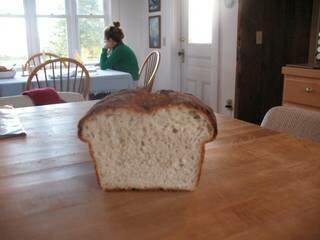 Right now I’m on a rare vacation in rural Vermont: taking walks, looking at leaves and hosting house guests; and while house guests are really just friends, when then are staying with you they become something else. They become people whose needs are your problem. They become people who require coffee and sustenance. Hopefully they can make coffee. All you need to do is make some Oatmeal Bread.
Right now I’m on a rare vacation in rural Vermont: taking walks, looking at leaves and hosting house guests; and while house guests are really just friends, when then are staying with you they become something else. They become people whose needs are your problem. They become people who require coffee and sustenance. Hopefully they can make coffee. All you need to do is make some Oatmeal Bread.
This bread is an old-school American sandwich loaf--the kind we have all but forgotten about in our current mania for crusty, European-style breads. There exists a powerful collective nostalgia for this type of bread, and yet it is the type of all-purpose loaf that is almost impossible to find. It’s soft and homey, perfect with butter or as peanut butter toast, equally delicious when made into grilled cheese or as the foundation for glorious leftover-roast-chicken sandwiches. In other words, it will feed your guests for several meals a day and leave you time to do the crossword.
Made with rolled oats, a bit of honey and...
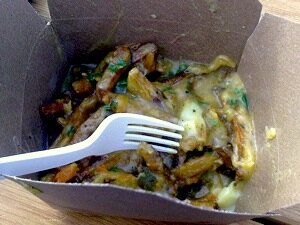 Skillet's poutine, courtesy of The SunBreak Flickr Pool member 7502winona
Skillet's poutine, courtesy of The SunBreak Flickr Pool member 7502winona
Seattle magazine, as a side order of their October issue street food coverage, have cooked up a cool idea, a Mobile Chowdown featuring some of Seattle's favorite food trucks: Marination Mobile, Skillet, Maximus Minimus, Kaosamai Thai, Gert's BBQ, El Camion, Parfait Ice Cream, and Dante's Inferno Dogs.
It's this Saturday, from 11 a.m. to 3 p.m., at 1616 W. Bertona in Interbay. There's also an ongoing Twitter contest for followers of @mobilechowdown. They're asking one question each day from October 1 until October 10, (total of 10 questions) all having to do with the food trucks or the prize providers. The prize is dinner for two at Tilth Restaurant, a night at the Sorrento Hotel, and a year's worth of Seattle magazine.
This is all very good. For a start. But the obvious question is why can't I have my street food in one convenient location all the time? (Convenient, by the way, rules out Interbay.) This kind of forward-thinking is one more area in which Portland has Seattle beat. First of all, Food Carts Portland shames us with its very existence and abundance of wagon-prepared fare.
View Larger Map
But secondly, Portland has a street food corral downtown, where a wagon train of street food vendors have set up shop on the perimeter of what I vaguely remember to be a parking lot. This is a stroke of genius. Downtown workers are always in a rush to get a cheap lunch.
We still have the chance to one-up PDX on this, though.
We could line Occidental Square with carts (or run them down the center). That would give people (besides our wishfully labeled "transient" population) a reason to sit down and enjoy the tables and chairs set out there. If we wanted to progressive about it, we could even use the rent the city charged the carts to fund homeless services in the area. Who do we talk to about getting this going?
Béchamel, the classic white sauce used to make all manner of wonderful things--Macaroni and Cheese, the Croques (Monsieur and Madame) and Savory Soufflés to name a few--should unquestionably be part of your cooking repertoire. It’s not at all difficult and yet, it’s the culinary obstacle you never knew was there. Learn how to make it and doors will open for you.
Béchamel sauce (or more snooty-like: Sauce Béchamel) is a sauce that comes from the French culinary tradition and thus any discussion that ignores Mrs. Julia Child would be both callous and unwise, especially because ever since that Julie and Julia movie came out, everyone and their mothers (including both my mother and stepmother) went out and bought a copy of Mastering the Art of French Cooking.
If you have your copy in front of you, you’ll see that on page 57 Julia leads off the sauce chapter with this all-important sauce. Along with many many Americans, I learned how to make béchamel from this...
In 2002, cookbook author Dorie Greenspan published a recipe for some chocolate cookies that sent cooks and newly minted food bloggers into a baking frenzy. Everyone was making these cookies, even more people were eating them. I however, had no idea. Not yet a pastry chef, I was still in college underlining long meaningful passages in Jane Eyre and baking boring banana bread for a boyfriend who “didn’t really like food.” A mere seven years later, installed in my joyful profession and making better dating choices, I finally caught up and made these sublime cookies. They are called Korova Sablés and they are perfect.
These cookies are the delicious love child of Pierre Hermé and Dorie Greenspan. Hermé is a giant of French Pastry and the owner of Pierre Hermé Paris, perhaps the most tantalizing place in all of Paris, at least for the pastry-inclined. Dorie Greenspan is a master recipe writer and baker, known for her collaborations with not only Pierre Hermé, but also Julia Child and Daniel Boulud.
 I had to beg permission for this photo of Pierre Hermé's bakery.
I had to beg permission for this photo of Pierre Hermé's bakery.
The recipe for Korova Sables is perhaps the only recipe that I’ve never been tempted to change. It is a rare perfect recipe, the product of Hermé’s genius and Greenspan’s diligence. Their collaboration is essential: it’s one thing for a professional chef to make a delicious cookie, but it’s quite another to accurately quantify the recipe and describe the technique such that anyone can reproduce it. For putting these cookies within our reach, we have Greenspan to thank.
As for the cookies themselves, Korova Sablés are simple chocolate cookies. They are crisp and crumbly with just the right amount of chew in the very center. Made with fancy cocoa powder, small chunks of chocolate and an extra bit of salt, they are intense, but delicate. I make them at every opportunity and they are loved by men, women, children and my date for tonight. Make them exactly as the recipe below states and please, please don’t change a thing.
Korova Sablés
Adapted from Dorie Greenspan and Pierre Hermé, makes about 30 cookies.
This cookie relies heavily on choice ingredients, specifically the cocoa powder and the chocolate. The cocoa powders I would recommend, in order of preference, are: Valrhona (available at DeLauretis and Whole Foods), Guittard Cocoa Rouge (Sur La Table) and Scharffen Berger (most yuppie grocery stores). As for the chocolate, just use something you like, preferably 55% cocoa solids or higher, and not chocolate chips.
1 1/4 cups all-purpose flour
1/3 cup high-quality cocoa powder
1/2 teaspoon baking soda
5 1/2 ounces unsalted butter, at room temperature
2/3 cup packed light brown sugar
1/4 cup granulated sugar
1/2 teaspoon kosher salt
1 teaspoon pure vanilla extract
5 ounces high-quality bittersweet chocolate, chopped into small pieces
large crystal or sanding sugar for edges (optional)
Sift the flour, cocoa powder, and baking soda together and set aside. In the bowl of a stand mixer fitted with the paddle attachment, or by hand, cream the butter with both of the sugars, the salt and vanilla until light, about 30 seconds on the mixer or about a minute by hand. Add dry ingredients and chopped chocolate and mix on low until just combined. You will probably have to stop the mixer halfway through to scrape down the sides of the bowl and the paddle. If the dough looks a little dry and crumbly at this point, that’s okay, you want to mix the dough as little as possible to keep the cookies tender. Press the dough into two logs about 1 1/2” in diameter. Chill for at least 30 minutes, or alternatively, freeze for up to two weeks.
Before baking, roll the logs in large crystal sugar (if using) and slice into rounds between 1/4 and 1/2" thick. On an ungreased sheet pan, bake cookies in a preheated 325 F oven for 16 minutes, rotating once at the midpoint, or until the edges of the cookies are set, but the centers are still slightly soft.
Hello!
Twitter: @thesunbreak | Facebook
iPhone app download (Free!)
Subscribe to The SunBreak
Delivery Options
![]() Subscribe to all SunBreak Stories
Subscribe to all SunBreak Stories
Daily Email Digest of The SunBreak
Most Viewed Stories
Latest Headlines
Recently in Our Flickr Photo Pool
www.flickr.com
|
Our Facebook Fan Page
Neighborhood Blog News
Niche Blog News
Seattle Weather
Get the SunBreak iPhone App

Download the SunBreak iPhone app for free.


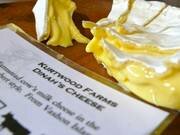
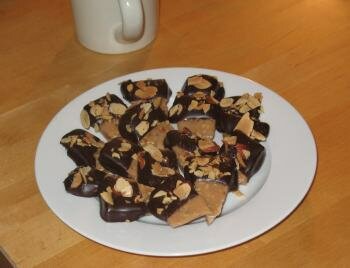

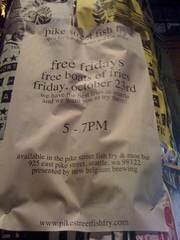
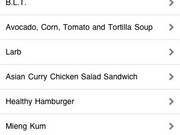
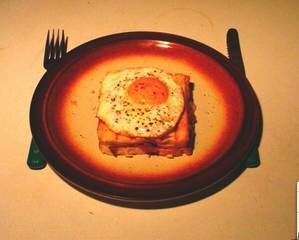




Most Recent Comments